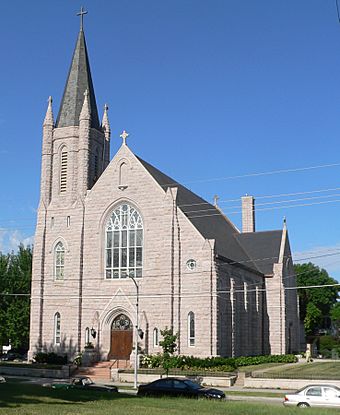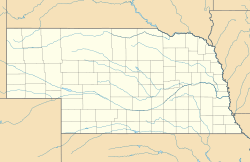Sacred Heart Catholic Church (Omaha, Nebraska) facts for kids
Quick facts for kids |
|
|
Sacred Heart Catholic Church Complex
|
|

Church seen from northeast
|
|
| Location | 2218 Binney Street, Omaha, Nebraska |
|---|---|
| Built | 1900 |
| Architect | Fisher & Lawrie |
| Architectural style | Gothic revival |
| NRHP reference No. | 83001093 |
| Added to NRHP | March 24, 1983 |
Sacred Heart Catholic Church is a historic Catholic church located at 2206 Binney Street in the Kountze Place neighborhood of North Omaha, Nebraska. It is part of the Archdiocese of Omaha.
Contents
About Sacred Heart Church
Sacred Heart Catholic Church was built in 1902. It features a beautiful design known as the Late Gothic Revival style. This style often includes pointed arches, tall windows, and detailed stone work, similar to old European cathedrals.
The City of Omaha recognized the church as an important landmark in 1979. Later, in 1983, it was added to the National Register of Historic Places. This list includes places across the United States that are important to history or architecture.
The Church's Location and History
The church was built on land given by Herman Kountze, a real estate investor from Omaha. He created a housing area called Kountze Place. This area was once a "streetcar suburb," meaning people could easily travel to and from the city center using streetcars.
Over time, the neighborhood around Sacred Heart Church changed. Many families moved away, which meant fewer people lived close to the church. However, Sacred Heart adapted and became a welcoming church for people from all over the city.
Today, Sacred Heart Church continues to serve its community. It has a busy parish and an elementary school for local students. The church also runs community outreach programs, helping people in the neighborhood. It is still recognized as an official Omaha Landmark.
More to Explore
- Architecture in North Omaha, Nebraska
- Roman Catholic Archdiocese of Omaha
- List of churches in Omaha, Nebraska
Online Resources
- Sacred Heart parish website
- Sacred Heart school website
- "A History of the Sacred Heart Parish in Omaha" by Adam Fletcher Sasse for NorthOmahaHistory.com
- Sacred Heart CUES, a non-profit group that helps Sacred Heart School
- Modern photo
- Historic Postcard - Nebraska Memories



